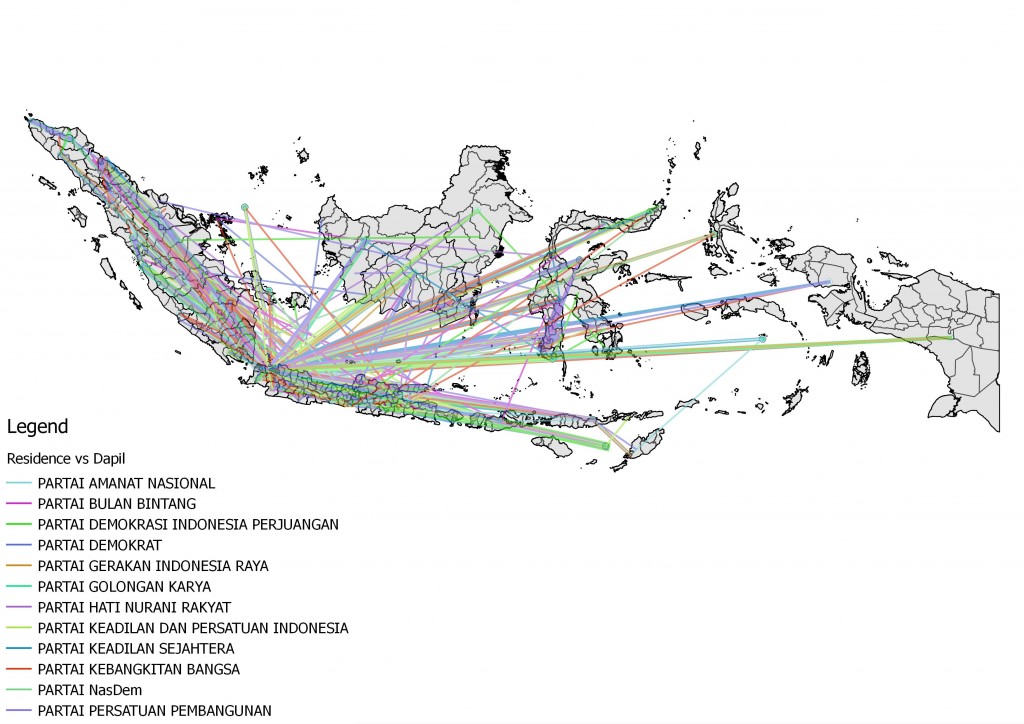Without residency requirements, candidates running for seats in the DPR this April are free to stand for election anywhere they (or their party) choose.
Using open-source GIS tools and a recently published dataset as part of the PemiluAPI project, I created the graphic below, which helps to visualize the incredibly complex nature of political representation in Indonesia’s upcoming legislative election. Each line is color coded by party, which helps to highlight the fact that each of the 12 parties competing for power this April are contributing to this phenomenon of candidate “migration”.
Of the 6,606 candidates running for office, just shy of 4,300 live outside of the electoral district in which they are running. One candidate, running under the Gerindra banner, was so bold as to list Kuala Lumpur as her place of residence. It’s hard to believe that will be a popular choice among voters.

On the move: The graphic above shows the migration of legislative candidates throughout the archipelago, from their places of residence to their electoral districts of choice. Based on GIS analysis, this jumbled picture is fitting of the complexity of choices facing voters as they head to the polls on April 9. Graphic credit: Justin Snyder
Golkar tops the list in terms of both absolute numbers of non-resident candidates (at 415 out of 560, or 74%), followed closely by Hanura (414, 74%) and Democrat (409, 73%). The somewhat discredited PKS party fielded the lowest percentage of non-resident candidates at 44% – however, it is worth pointing out that its total list was nearly 70 candidates short of the full 560. For a full breakdown, see below:
| Party |
Non-resident Candidates |
Total Candidates |
% |
| Grand Total |
4292 |
6606 |
65% |
| Golkar |
415 |
560 |
74% |
| Hanura |
414 |
558 |
74% |
| Democrat |
409 |
560 |
73% |
| PDI-P |
398 |
560 |
71% |
| PKPI |
380 |
539 |
71% |
| PAN |
378 |
559 |
68% |
| PBB |
375 |
556 |
67% |
| Gerindra |
359 |
557 |
64% |
| PPP |
327 |
548 |
60% |
| PKB |
318 |
558 |
57% |
| NasDem |
301 |
559 |
54% |
| PKS |
218 |
492 |
44% |
The picture becomes somewhat clearer when we turn our attention to the 3,339 candidates who officially reside in the Greater Jakarta area (see graphic below).

On the move: The graphic above shows the migration of legislative candidates from Greater Jakarta to the electoral districts they stand to represent should they come out on top of the April poll. Graphic credit: Justin Snyder
A certain degree of opportunism is to be expected, especially given the lack of residency requirements. However my analysis of data, made publically available by election watchdog Perludem, reveals the shocking scale of the phenomenon.
In three electoral districts (NTT I, RIAU II, SULAWESI SELATAN II), fewer than 7.5% of the candidates are actually residents. This is partially attributable to the presence of large urban centers in the adjacent district, and so some natural spillover occurs; however this does not entirely explain the trend nationwide. Voters in a mere 21 out of the 77 DPR districts will be presented with a ballot predominately filled (50% or more) with candidates who actually live in the district.

You’re not from around here, are you?: The graphic above shows the extent to which candidates standing in a particular district actually reside there as well, with the lowest percentages of resident candidates shaded in red. Graphic credit: Justin Snyder
A worthwhile question is whether any of this matters? Does a candidate necessarily have to live in a district to have its best interests at heart? Or put differently, does a candidate’s ability to create new legislation depend on where they are from? The answer is an obvious “no”, but it comes with an important caveat – a candidate and future politician may not need to live in an area to pass legislation, but their ability to pass relevant legislation that effectively addresses the primary concerns of their constituents, I would argue, is significantly reduced if the only meaningful interaction with the public is through polished media campaigns and staged site visits.
After the shallow “festival of democracy” has concluded on April 9, what will remain of the deeper concept of democratic representation when the new-elects are inaugurated on October 1?
………
Justin Snyder works with a variety of organizations on democratic governance and development issues in Indonesia.
 Facebook
Facebook  Twitter
Twitter  Soundcloud
Soundcloud  Youtube
Youtube  Rss
Rss 